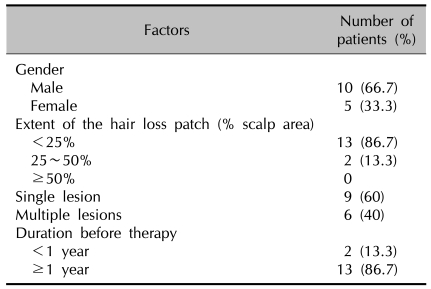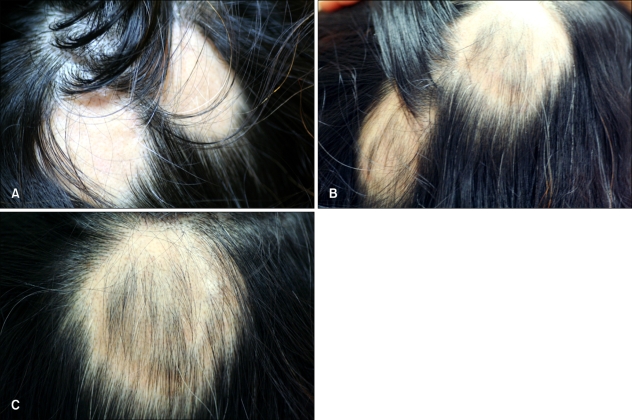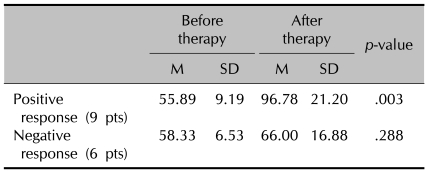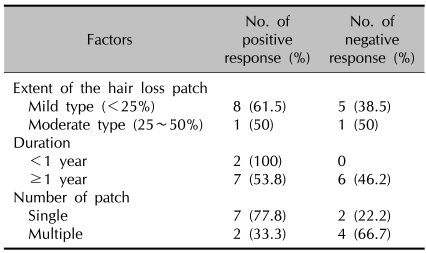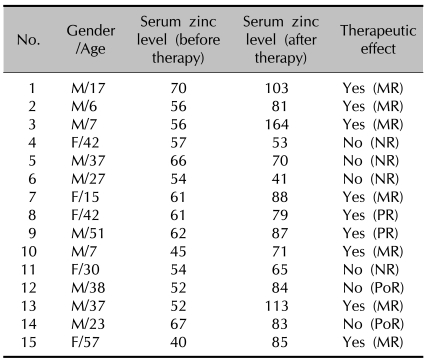Abstract
Background
It has been reported that some alopecia areata patients have zinc deficiency. There have also been several reports published concerning oral zinc sulfate therapy, with encouraging results, in some alopecia areata patients.
Objective
The purpose of this study was to evaluate the therapeutic effects of oral zinc supplementation for twelve weeks in alopecia areata patients who had a low serum zinc level.
Methods
Oral zinc gluconate (50 mg/T/day) supplementation was given to alopecia areata patients without any other treatment for twelve weeks. The serum zinc level was measured before and after zinc supplementation. A four-point scale of hair regrowth was used to evaluate the therapeutic effect of oral zinc supplementation in these patients.
Results
Fifteen alopecia areata patients were enrolled in this study. After the therapy, the serum zinc levels increased significantly from 56.9 µg/ to 84.5 µg/dl. Positive therapeutic effects were observed for 9 out of 15 patients (66.7%) although this was not statistically significant. The serum zinc levels of the positive response group increased more than those of the negative response group (p=0.003).
Conclusion
Zinc supplementation needs to be given to the alopecia areata patients who have a low serum zinc level. We suggest that zinc supplementation could become an adjuvant therapy for the alopecia areata patients with a low serum zinc level and for whom the traditional therapeutic methods have been unsuccessful.
Keywords: Alopecia areata, Serum zinc level, Zinc supplementation
INTRODUCTION
Oral zinc compounds have been used for decades for treating disorders such as telogen effluvium1,2 and alopecia areata3,4. Reports have also been published on oral zinc sulfate therapy with encouraging results for some cases of alopecia areata. In 1976 Wolowa and Jablonska5 reported that two patients with alopecia areata regrew their hair after treatment with oral zinc sulfate. It has been reported that some alopecia areata patients have zinc deficiency6-8. Zinc is an essential cofactor for multiple enzymes and it is involved with important functional activities in the hair follicle. Further, zinc is a potent inhibitor of hair follicle regression and it accelerates hair follicle recovery6,7. In the present study, we examined the serum levels of zinc in alopecia areata patients. We studied the therapeutic effect of 12 weeks oral zinc supplementation for treating alopecia areata patients who have a low serum zinc level and we checked their serum zinc level after this oral zinc supplementation.
MATERIALS AND METHODS
Patients
Forty four alopecia areata patients were checked for their serum zinc levels. After the zinc levels were checked, 15 alopecia areata patients who each had a low serum zinc level (Zn≤70 µg/dl) were enrolled in this study. Ten were males and five were females (mean age: 29.1±16.2 years). All of these patients had had alopecia areata for at least 6 months before visiting our clinic for treatment. These patients had reported no effect from other therapeutic methods or they had had no treatment history for more than 6 months before visiting our clinic. The sera obtained from the 15 alopecia areata patients were used as test materials.
Methods
Supplementation with oral zinc gluconate tablet (50 mg/tablet/day, zinc 50, GNC, USA) was used as a therapeutic method for twelve weeks without any other treatment. Each patient's serum zinc level was measured before and after supplementation therapy. We defined a mild type of alopecia areata as hair loss of less than 25% of the total scalp hair, a moderate type of alopecia areata was defined as hair loss between 25% and 50% of the total scalp hair and a severe type of alopecia areata was defined as hair loss of more than 50% of total scalp hair. The therapeutic effects of oral zinc supplementation in alopecia areata patients were evaluated through the extent of vellus hair and terminal hair regrowth on the scalp. We graded the therapeutic effects as follows:
(1) Marked recovery: cosmetic satisfaction or terminal hair regrowth of more than 60% on the hair loss patch
(2) Partial recovery: terminal hair regrowth less than 60% on the hair loss patch
(3) Poor recovery: only vellus hair regrowth on the hair loss patch
(4) No recovery: aggravation or an unchanged alopecia areata state as compared to before therapy
Of the 4 grades, we defined that the positive therapeutic effects were marked and partial recovery9,10. With maintaining zinc supplementation for at least 6 months, the positive response group was followed up for continuous terminal hair regrowth and recurrence of alopecia areata.
Statistical analysis
The results were expressed as means±standard deviations. The Chi-square test was used for statistical analysis. A p value≤0.05 was considered statistically significant.
RESULTS
All of the 15 subjects completed this study. They were enrolled from September 2006 to August 2007. The patient information is shown in Table 1. After the zinc supplementation the mean serum zinc level changed from 56.9 µg/dl to 84.5 µg/dl. The results of the changed serum zinc levels are shown in Table 2, and the differences of the zinc serum levels were statistically significant before and after supplementation therapy (p=0.002). Positive therapeutic effects were seen in 9 out of 15 patients (66.7%). Out of the 9 patients with positive therapeutic effects, 7 patients showed a marked recovery (Fig. 1) and 2 patients showed a partial recovery. However, the therapeutic effects were not statistically significant (p=0.439, Table 3). After zinc supplementation, there was a difference of the serum zinc level between the positive response group and the negative response group. The serum zinc level of the positive response group increased by 40.9 µg/dl and that of the negative response group increased by 7.7 µg/dl. In the positive response group, the serum zinc levels after therapy were significantly higher than those before therapy (p=0.003). The changed serum zinc levels are shown in Table 4. The patients with mild alopecia areata and who had a single alopecia areata patch displayed more positive results than the patients who had multiple alopecia areata patches (Table 5). Two patients complained of mild nausea as a side effect. The summary of the patients is shown in Table 6.
Table 1.
Clinical data of the 15 patients with alopecia areata
Table 2.
Serum zinc levels in the alopecia areata patients before and after therapy
M: mean, SD: standard deviation
Fig. 1.
(A) Pre-treatment. Relatively well defined 3×5 cm-sized and 4×6 cm-sized oval shaped hair loss patches (No.15). (B) Post-treatment. We recognized terminal hair growth from the hair loss patches. (C) The patient showed marked recovery after 12 weeks.
Table 3.
Therapeutic effects
pts: patients, MR: marked recovery, PR: partial recovery, PoR: poor recovery, NR: no recovery
Table 4.
Serum zinc levels before and after supplementation therapy
M: mean, SD: standard deviation, pts: patients
Table 5.
Therapeutic effect by the extent and duration of alopecia areata and the number of hair loss patches
Table 6.
Summary of the patients
MR: marked recovery, PR: partial recovery, PoR: poor recovery, NR: no recovery
DISCUSSION
There are several reports stating that the serum zinc level is low in alopecia areata patients7,11-13. However, the pathogenesis of this reduced serum zinc level is unknown. As cofactors of metalloenzymes, zinc has considerable effects on nearly all aspects of the metabolism that takes place in the organs of the body, including the skin. In fact, congenital and acquired zinc deficiencies are usually expressed as a variety of skin manifestations such as acrodermatitis enteropathica, psoriasis-like eruptions, blisters, onychopathy and loss of hair6,14. Several reports have shown that oral administration of zinc compounds improved hair growth5. Yet in 1981, Ead15 reported that oral administration of zinc compounds had no therapeutic effect on hair loss. Ead15 found that after zinc supplementation, the serum zinc level changed from 77.5 µg/dl to 112.2 µg/dl and the serum zinc level increased by 34.7 µg/dl, but the patients did not show a positive therapeutic effect. In this study, 6 out of 15 patients belonged to the negative response group. Among this negative response group, 4 patients' serum zinc levels increased and 2 patients' serum zinc levels decreased. We think that the increased serum zinc levels in the 4 patients are related to another cause. The serum zinc level of three patients except patient No. 12, increased less than those of the positive response group. We thought that the No.12 patient's cause of hair loss was related to stress and fatigue. Two patients with decreased serum zinc levels had an irregular oral zinc tablet intake during this study. Zinc is a metal moiety of many enzymes and it is indispensable for normal cellular function and it has important roles in bone formation, cell-mediated immunity, the general immunological defense of the host and tissue growth. Zinc provides structural integrity to enzymes and/or it participates directly in catalysis. Examples of zinc metalloenzymes include DNA and RNA nucleotidyl transferases, alcohol dehydrogenase, glutamic, lactic and malic dehydrogenase and δ-aminolevulinic acid dehydratase16. The etiology of alopecia areata is still unknown. Several kinds of treatments have been tried with various results, i.e., oral and topical corticosteroids, triamcinolone intralesional injection, photochemotherapy, topical irritants and allergens, immunosuppressants and cryotherapy. Checking the serum zinc level is necessary to evaluate hair loss of an unknown cause, and zinc supplementation may be needed in the alopecia areata patients who have a low serum zinc level. In this study, after adhering to zinc supplementation for twelve weeks, the patients' mean serum zinc level changed from 56.9 µg/dl to 84.5 µg/dl, and the level increased by 27.60 µg/dl. When analyzing the differences between the positive and negative response groups, the positive response group increased their serum zinc level by 40.9 µg/dl, and the negative response group increased their serum zinc level by 7.7 µg/dl. This difference was statistically significant. Those patients with mild alopecia areata and those with a single alopecia areata patch had a greater positive response than the patients with moderate alopecia areata and those with multiple alopecia areata patches. The positive response group maintained zinc supplementation for at least 6 months with no recurrence of their hair loss being seen during their follow-up. The positive response group also showed continuous terminal hair regrowth during follow-up. Although these patients had a mild type of long term alopecia areata, zinc supplementation can become a possible adjuvant therapy when combined with other therapeutic methods, and especially for those alopecia areata patients with a low serum zinc level. Prior to this study, there has only been one report of alopecia areata patients having a low serum zinc level in the Korean medical literature3 and there has been no report about the therapeutic effects of zinc supplementation in Korea. This study was the first in Korea to evaluate the therapeutic effects of twelve weeks of oral zinc supplementation in alopecia areata patients with a low serum zinc level and we reported on the changing serum zinc levels after oral zinc supplementation. Positive therapeutic effects were seen in 9 out of 15 patients, but because of the small numbers of patients, the therapeutic effects were not statistically significant. Subsequent studies with a large number of alopecia areata patients are needed to clarify the therapeutic effects of oral zinc supplementation.
References
- 1.Carruthers R. Post-partum alopecia and zinc. Med J Aust. 1983;2:259. [PubMed] [Google Scholar]
- 2.Arnaud J, Beani JC, Favier AE, Amblard P. Zinc status in patients with telogen defluvium. Acta Derm Venereol. 1995;75:248–249. doi: 10.2340/00015555752478249. [DOI] [PubMed] [Google Scholar]
- 3.Camacho FM, Garcia-Hernandez MJ. Zinc aspartate, biotin, and clobetasol propionate in the treatment of alopecia areata in childhood. Pediatr Dermatol. 1999;16:336–338. doi: 10.1111/j.1525-1470.1999.pdele65.x. [DOI] [PubMed] [Google Scholar]
- 4.Slonim AE, Sadick N, Pugliese M, Meyers-Seifer CH. Clinical response of alopecia, trichorrhexis nodosa, and dry, scaly skin to zinc supplementation. J Pediatr. 1992;121:890–895. doi: 10.1016/s0022-3476(05)80334-8. [DOI] [PubMed] [Google Scholar]
- 5.Wolowa F, Jablonska S. Zinc in the treatment of alopecia areata. In: Kobori T, Montagna W, Toda K, editors. Biology and disease of the hair. 2nd ed. Tokyo: University of Tokyo Press; 1976. pp. 305–308. [Google Scholar]
- 6.Plonka PM, Handjiski B, Popik M, Michalczyk D, Paus R. Zinc as an ambivalent but potent modulator of murine hair growth in vivo-preliminary observations. Exp Dermatol. 2005;14:844–853. doi: 10.1111/j.1600-0625.2005.00365.x. [DOI] [PubMed] [Google Scholar]
- 7.Lee SY, Nam KS, Seo YW, Lee JS, Chung H. Analysis of serum zinc and copper levels in alopecia areata. Ann Dermatol. 1997;9:239–241. [Google Scholar]
- 8.Weismann K, Hagdrup HK. Hair changes due to zinc deficiency in a case of sucrose malabsorption. Acta Derm Venereol. 1981;61:444–447. [PubMed] [Google Scholar]
- 9.Hong SP, Jeon SY, Oh TH, Lee WS. A retrospective study of the effect of superficial cryotherapy on alopecia areata. Korean J Dermatol. 2006;44:274–280. [Google Scholar]
- 10.Tak WJ, Chung YS, Ro BI. A clinical study on alopecia areata (1996-2000)(TGF-VI) Korean J Dermatol. 2002;40:791–800. [Google Scholar]
- 11.Tasaki M, Hanada K, Hashimoto I. Analyses of serum copper and zinc levels and copper/zinc ratios in skin diseases. J Dermatol. 1993;20:21–24. doi: 10.1111/j.1346-8138.1993.tb03823.x. [DOI] [PubMed] [Google Scholar]
- 12.Malanin K, Telegdy E, Qazaq H. Hair loss and serum zinc values among Arab females in Al Ain region, United Arab Emirates. Eur J Dermatol. 2007;17:446–447. doi: 10.1684/ejd.2007.0248. [DOI] [PubMed] [Google Scholar]
- 13.Mussalo-Rauhamaa H, Lakomaa EL, Kianto U, Lehto J. Element concentrations in serum, erythrocytes, hair and urine of alopecia patients. Acta Derm Venereol. 1986;66:103–109. [PubMed] [Google Scholar]
- 14.Rushton DH. Nutritional factors and hair loss. Clin Exp Dermatol. 2002;27:396–404. doi: 10.1046/j.1365-2230.2002.01076.x. [DOI] [PubMed] [Google Scholar]
- 15.Ead RD. Oral zinc sulphate in alopacia areata-a double blind trial. Br J Dermatol. 1981;104:483–484. doi: 10.1111/j.1365-2133.1981.tb15323.x. [DOI] [PubMed] [Google Scholar]
- 16.Cousins RJ. Absorption, transport, and hepatic metabolism of copper and zinc: special reference to metallothionein and ceruloplasmin. Physiol Rev. 1985;65:238–309. doi: 10.1152/physrev.1985.65.2.238. [DOI] [PubMed] [Google Scholar]



